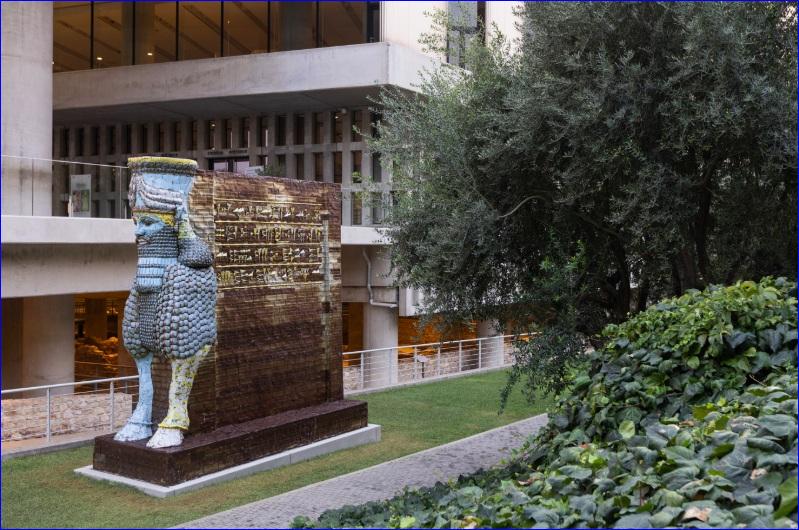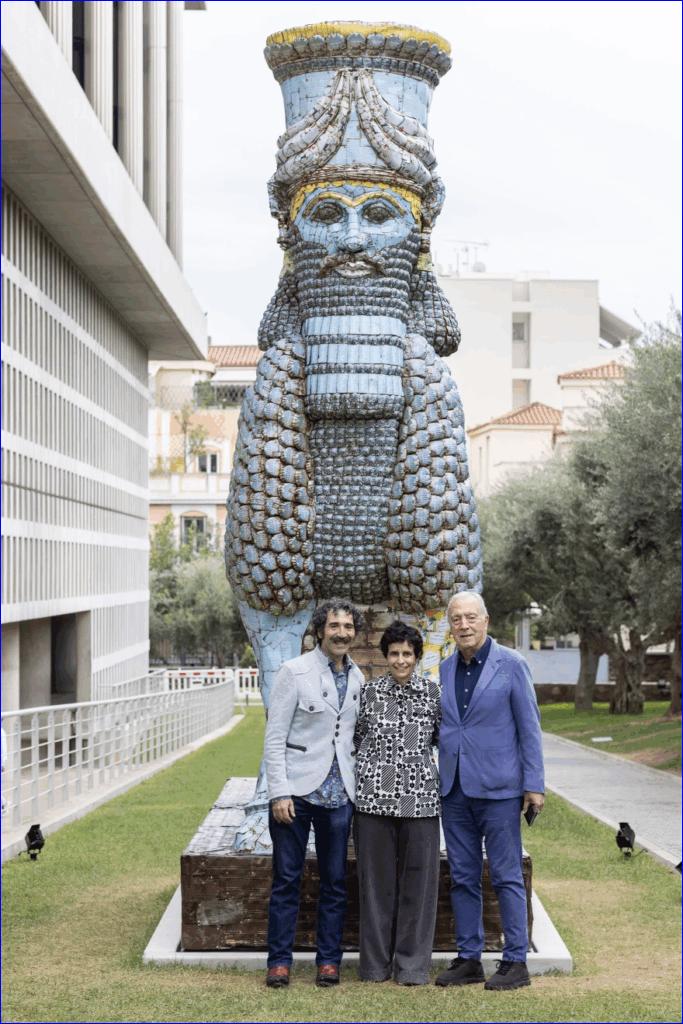


The installation, titled Lamassu of Nineveh, is the creation of internationally acclaimed Iraqi-American artist Michael Rakowitz. It forms the second part of the trilogy "Michael Rakowitz & Ancient Cultures", presented at the Acropolis Museum in collaboration with the Greek Ministry of Culture, the Ephorate of Antiquities of Athens, and the organization NEON. The project aims to highlight the devastating consequences of war while sending a message of rebirth and reconciliation through art and cultural dialogue.
The choice of materials is deeply symbolic. The cans used by Rakowitz are made from discarded containers of Iraqi date syrup -- remnants of what was once a thriving national industry, decimated by decades of conflict and sanctions. In doing so, the artist adds a new layer to the story of Iraq's cultural, economic, and ecological losses.
This sculpture belongs to Rakowitz's long-running series The Invisible Enemy Should Not Exist, begun in 2006, which reconstructs ancient artifacts looted from the National Museum of Iraq and other archaeological sites following the 2003 U.S. invasion.
"It is an honor to collaborate with a museum whose very DNA is built on the effort to reunite people with their rightful heritage,"
said Michael Rakowitz at the unveiling, making a subtle reference to Greece's ongoing campaign for the reunification of the Parthenon Marbles.
"For me, this is one of the most important museums in the world -- a beacon for nations seeking to reconnect their people with their history."
The impressive 4.3-meter-long sculpture, now on display in the museum's forecourt until October 31, 2026, recreates the ancient Assyrian protective deity that once stood at the Nergal Gate of Nineveh from around 700 B.C. until February 2015, when it was destroyed by ISIS along with other priceless antiquities in nearby Mosul.
The reverse of the sculpture features a cuneiform inscription, once hidden from public view, that Rakowitz has reproduced prominently. It reads:
"Sennacherib, king of the world, king of Assyria, had the inner and outer walls of Nineveh built anew and raised high as mountains."
During the presentation, Nikolaos Stampolidis, Director of the Acropolis Museum and co-curator of the exhibition, described the experience of seeing the sculpture installed as "almost metaphysical":
"It was evening, there was light rain, and suddenly the moon appeared through the clouds. At that moment, I was looking at the inscription about King Sennacherib, who called himself 'King of the World.' His name -- Sin, Ahe, Eriba -- means 'the god Sin has replaced the brothers.' Sin is the god of the Moon. It was as if the god of the Moon himself had returned for Sennacherib."

Stampolidis went on to emphasize the moral of the work:
"Even as our technological knowledge soars, humanity seems to decline. This is a constant and complex issue, particularly for the regions of the East and the Eastern Mediterranean. I hope we can turn walls into bridges -- when we think of the people to whom the Lamassu belongs, those who fled war in Iraq, Syria, or today from the genocide in Palestine. I hope this work brings some sweetness to the tongues of those who may welcome them as new neighbors."
Elena Kountouri, co-curator of the exhibition and director of NEON, added:
"In this trilogy, Michael Rakowitz highlights the importance of other cultures. Rather than focusing solely on the beauty of Classical Greece, we take a step further -- using the visual language and sculptural tradition of another civilization to express universal and timeless human ideas."
Finally, as part of the exhibition program, a lecture titled "Heritage, Genocide, and Memory" will be held on Monday, October 6, 2025, at 6:00 p.m. in the Acropolis Museum Auditorium. The talk will be delivered by Dr. Alda Benjamen, Assistant Professor of History at the University of Dayton and specialist in the modern history of the Middle East. Admission will be free to the public.

or register to post a comment.